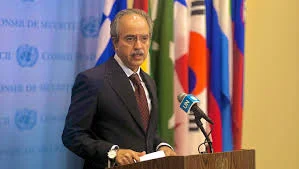Pakistan’s address to the UNSC foregrounded a stark warning: abandoned and illicit weapons in Afghanistan have been migrating into the hands of armed non‑state actors, creating a direct threat to Pakistan’s security and regional stability.
Ambassador Asim Iftikhar Ahmad told the Council that findings in UN reports point to stockpiles of sophisticated arms and ammunition in Afghanistan and to illicit markets and transfer routes that risk fuelling cross‑border violence. The problem is not merely a historical residue of past conflicts; it is an active, transnational phenomenon with humanitarian and geopolitical consequences.
Operational and Human Costs
The practical outcome is clear: better weapons equal greater lethality. Pakistan cited credible instances where modern arms seized at the border could be traced back to stockpiles left behind after foreign troop withdrawals, and where these weapons have been used by groups such as ISIL‑K, TTP, BLA, and other militias to strike civilians and security forces, producing thousands of casualties and widespread displacement. Illicit small arms and light weapons have therefore become central tools in asymmetric campaigns that erode public safety, undermine governance, and impede reconstruction in affected areas.
Drivers of Proliferation and the Criminal Economy
Multiple drivers sustain this flow: leftover military materiel, porous borders and weak controls, active black markets, and transnational criminal and financing networks that monetize insecurity. Ambassador Ahmad underscored in the UNSC that some confiscated weapons trace directly to equipment abandoned during the August 2021 withdrawal, while illicit markets in Afghanistan have matured into channels for diversion and smuggling, a dynamic that amplifies risks for neighbouring states. Addressing the problem requires confronting both supply‑side stockpiles and demand‑side incentives that perpetuate arms trading.
New Technologies, Regulatory Gaps, and Policy Complexity
The challenge is compounded by evolving technologies and modalities of violence. Commercial drones, modular and 3D‑printed components, and other dual‑use items complicate conventional arms control paradigms, creating regulatory blind spots. Pakistan urged that global instruments such as the UN Programme of Action on Small Arms be adapted and fully implemented to address these contemporary threats while balancing legitimate state security needs with measures to curb illicit flows. Strengthening export controls, improving forensic tracing capacity, and expanding information‑sharing are immediate policy priorities.
Regional Cooperation and Multilateral Responses
No single country can solve the problem alone. The message at the UNSC was an appeal for coordinated regional and multilateral action: harmonized customs and border management, intelligence exchange, capacity building for stockpile management, and financial controls to disrupt procurement networks. Pakistan called on the Afghan interim authorities to honour international obligations regarding weapons control, while urging the international community to step up collective efforts to impede the access of terrorist groups to illicit arms.
Broader Developmental and Humanitarian Impacts
Illicit arms flows do more than enable attacks; they corrode development prospects and exacerbate human rights violations. Health systems and emergency responders are stretched by higher casualty rates, humanitarian access is impeded, and cycles of displacement and insecurity deepen poverty and social fragmentation. Pakistan framed arms control as integral to broader stabilization and development goals, arguing that limiting weapon availability is a precondition for reconstruction and durable peace.
From Debate to Durable Action
The UNSC debate underscored an urgent policy pivot: align diplomatic concern with practical investments in interdiction, verification, and prevention. Concrete steps include expanding technical assistance for weapons tracing and stockpile security, modernizing legal frameworks for emerging technologies, strengthening regional interdiction mechanisms, and targeting financial channels that sustain illicit acquisition. Transparent reporting, independent monitoring and multilateral accountability mechanisms will be essential to build confidence and measure progress.
Conclusion
Pakistan’s intervention at the UNSC was a clarion call: the presence and diversion of sophisticated weapons originating in Afghanistan are not a contained problem but a regional multiplier of instability. Mitigating this threat will require a comprehensive strategy that couples interdiction with prevention, modernized arms‑control norms, regional cooperation, technical capacity building, and development‑oriented measures to reduce incentives for armed mobilization.
The UNSC debate should catalyze coordinated action rather than remain a diagnostic exercise; failing to do so risks allowing illicit arsenals to perpetuate cycles of violence across South and Central Asia
Also Read: Pakistan Condemns Terrorism Double Standards at United Nations



